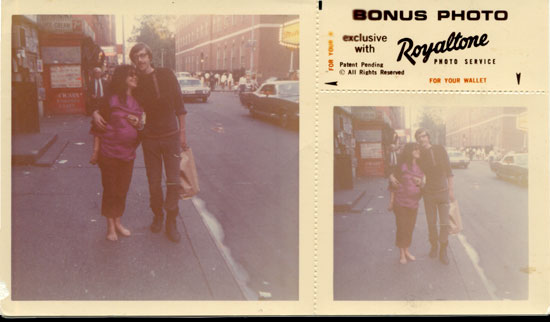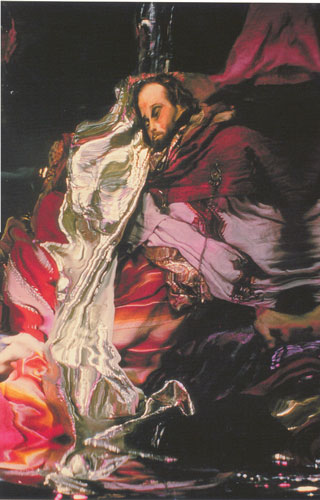 photo
by (who else) Ira Cohen
photo
by (who else) Ira Cohen |
I
like to say that Angus MacLise, by titling one of his recorded
jams "Blastitude" back in 1973, bequeathed upon me
a magic word. When I spoke this word aloud three times, an entire
web-zine was born. Really, all I needed was the name, and everything
else fell into place. Thanks Angus. -- Larry "Fuzz-O"
Dolman, editor.
ANGUS
MACLISE: MASTER OF SYNTHESIS
by RenÚ van der Voort
There is a story that when the Velvet Underground got an offer
for their first paid gig, Angus MacLise reacted by saying: "You
mean we start when they tell us to and we have to end when they
tell us to? I can't work that way." After which he left.
It
might be a myth but it shows a glimpse of the person he was,
a true free spirit and a highly individual multitalented artist.
Appearing in and out of a set of creative environments, never
staying long enough to get noticed by a broader public. A well
kept secret whose genius was only recently revealed, in part,
through a string of excellent CD's on the Quakebasket/Siltbreeze
label.
However,
as early as 1988, Fierce Records (an independent label dealing
mostly in loonies like Sky Saxon and Charles Manson) released
a single by Angus. The Trance 7" was wrapped in
a fantasy package, included were a chocolate bar, incense, rolling
paper and an order form for fake memorabilia. On the record
was an excerpt of Angus' comment on an Indian ceremony. Sadly
Fierce blew it all by stating in an interview with Strange Things
Magazine: "He used to record a lot of stuff but unfortunately
most of it was quite boring. Our record is everything you want
to listen to."
How
wrong can you be?
Most
people first heard of Angus MacLise because of his connection
with the Velvet Underground. Further investigation reveals that
he also has been a founding member of the Theatre of Eternal
Music, worked in multimedia and the Fluxus movement, designed
his own calligraphy, was a mystical poet, an actor, publisher,
bookshop owner and world traveller.
MacLise
was born in Bridgeport, Connecticut on March 4, 1938. At school
he developed an interest in music, especially percussion and
took lessons in Latin drumming. He studied jazz technique, medieval
European dance music and free form percussion.
During
his schooldays he befriended the poet Piero Heliczer with whom
he moved to Paris in the late fifties to establish the Dead
Language Press. They published Angus' early poetry: Imprimatur
1281 and Straight Farthest Blood Towards.
The
composer LaMonte Young found a copy of the letter and was immediately
fascinated by the quality of the carefully constructed poetry.
A well-directed stream of consciousness with surrealistic overtones.
When
Angus returned to the States he was invited to play in the LaMonte
Young Trio besides working at a number of Fluxus events with
Yoko Ono, Composer Henry Flynt and "chance" poet Jackson
MacLow.
In
1962 the Dead Language Press (now located in New York) issued
a new publication by Angus, the calendar poem Year. It
provided new names to each of the 365 days, a work of fiction
that offered a different way of thinking about everyday life
and was used by some artists to date their work.
He
participated in the upcoming underground film scene. Cheap 8
mm material became available and made it easier for aspiring
young filmmakers to shoot their often drug-induced exotic dream
movies using friends as actors.
Angus
appeared in many films, most notably the ones by Piero Heliczer.
Autumn Feast, for which he also helped with the soundtrack,
Venus in Furs with music by the embryonic Velvet Underground
and Joan of Arc, which Cahiers du Cinema called: "The
homemade movie of the Superstars." Ira Cohen, Gerard Malanga,
Rene Ricard, Jack Smith, Charles Henri Ford, Tuli Kupferberg
and many others all took part in this fantasy that combined
the revolution in the Arts at the time with the issues of the
Vietnam war.
Besides
acting Angus worked on soundtracks for Jerry Jofen, who had
the unhappy habit of destroying most of his creations as soon
as they were finished, and made the score for Chumlum
by Ron Rice. His hypnotic improvisations on the cembalum, that
seemed to go on forever, formed the perfect backdrop for the
Arabian nights vision of a psychedelic palace brothel in the
movie. The cembalum, a stringed instrument to be played with
sticks, was also used for some of his later scores of films
by Gerard Malanga, Don Snyder and Jonas Mekas with whom he worked
in 1966 on the movie Notes on the Circus. By accident
the music was erased so we will never know what it sounded like.
For
awhile Angus played live with LaMonte Young in front of the
screenings at the Filmmakers Cinematheque but most of the time
they held endless rehearsals at their Lower East Side apartment.
The group took off when next door neighbour (and future partner
of LaMonte) Marian Zazeela joined on vocals bringing in Billy
Linich (later Billy Name, of Warhol/Factory fame) on guitar.
Angus
organised a successful series of concerts at the 10-4 Gallery
in Manhattan. Using light projections they played a slow interpretation
of Indian drone music with a mastery of natural harmonics and
just intonation at an ear crushing volume. Among the enthusiastic
onlookers was violinist Tony Conrad who was asked to join the
group now called the Theatre of Eternal Music. When Linich left
he was replaced by the young Welsh musician John Cale, a classically
trained viola player and Xenakis scholar.
With
his amplified viola he added an extra dimension to the sustained
meditative drones on saxophone, strings and hand drums.
A
high level of perfection was reached but the discipline proved
too much for Angus who failed to show up at rehearsals and concerts
after awhile. He felt the urge to move on and split from the
group in February 1964 to go on a trip to Europe and the Middle
East.
While
working with the Theatre of Eternal Music, Cale started to play
with Lou Reed, a factory songwriter at Pickwick Records. Reed
had written and recorded The Ostrich, an attempt to create
a new dance craze. When the single got some airplay Cale and
Reed quickly assembled a group to promote the record. Recruiting
Tony Conrad and Walter deMaria (a drummer who played briefly
with LaMonte and was later to become a well known conceptual
sculptor), they went out on the road as the Primitives. After
playing high school gigs and local television shows for awhile
the action died down but Cale and Reed stayed together, eventually
forming a trio with guitarist Sterling Morrison.
On
his return to New York, Angus joined them to provide the music
for a ritual happening called Launching of the Dreamweapon.
It was the first theatrical event by Aquarium productions, set
up by Angus and his old friend Piero Heliczer, a display of
lights, dancers, poetry and improvised music from the group
who played behind a veil. The multimedia extravaganza gave them
a concept to work in and during the summer ofá '65 they were
the anonymous musicians who performed at screenings of underground
films by Barbara Rubin, Kenneth Anger and a second Aquarium
presentation Rites of the Dreamweapon.
Playing
under different names like the Warlocks and the Falling Spikes
they finally settled for the Velvet Underground. According to
legend it was either Angus who coined the name because he saw
a paperback with this title at a bookrack in Times Square or
Tony Conrad who found a copy of the book on a sidewalk.
Anyway
the name stuck and in an attempt to expand their audience they
put more structure in the music instead of free improvisation
only. A paid gig was offered, all but Angus were eager to accept,
and when he did not show up for the concert he got booted out.
His replacement was Maureen Tucker.
MacLise
was asked back though, strictly on a temporary basis, because
Lou Reed fell ill in June '66 when the group was booked for
a week in Chicago.
Angus
moved to Berkeley in early 1967 to join the Floating Lotus Magic
Opera Company, a street performance troupe where he met the
painter and illustrator Hetty McGee. They were married by Timothy
Leary during a ceremony in Golden Gate Park, San Francisco.
After
recording The Haight Riot Mime, a mesmerising combination
of Angus playing bongos and scat vocalising by Daniel Moore,
the newly wed couple returned to New York with a friend, Loudon
Wainwright III, behind the wheel.
During
the trip they got busted for possession of cannabis and were
transferred to the Oklahoma City jail. Wainwright's family bailed
him out immediately, Hetty and Angus stayed behind. It took
some time for their friends to gather the money needed for their
release and as soon as they arrived in New York a benefit mixed
media production was arranged to cover the costs.
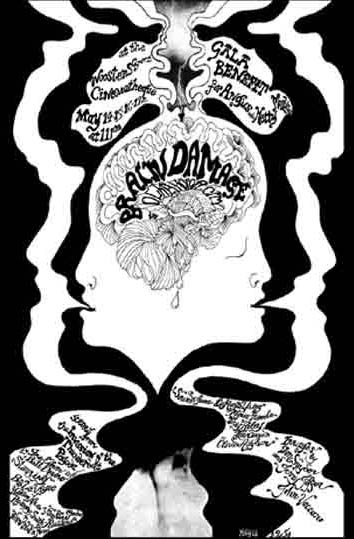 poster
by Hetty MacLise
poster
by Hetty MacLise |
Called
Brain Damage in Oklahoma City, it shook the Cinematheque
for four days straight in May. Images by Don Snyder and Jerry
Jofen were shown, the Theatre of Eternal Music performed as
did John Vaccaro's Theatre of the Ridiculous. Angus played his
Dreamweapon music with Hetty, Henry Flynt and Jackson Maclow.
Theiráset was taped, the interaction between the performers
was incredible. Nobody had a leading role, it's a complex tapestry
of voices, percussion and flutes wavering around for hours.
Ira Cohen showed scenes from his work in progress The Invasion
of Thunderbolt Pagoda. He had developed the Mylar Chamber,
a large box with bendable mirrors that resulted in all kinds
of wonderful warped effects which he filmed or photographed.
For
his movie Cohen had gathered all his friends, the Universal
Mutant Repertoire Company, and filmed them in exotic clothing
and ambience while they were singing, playing and groping around,
producing spectacular images that look as fresh today as when
they were filmed. Ira used some music from the benefit concert
for the movie but the bulk of the soundtrack was played live
when the completed film was shown at St. Mark's Church in 1968.
It is an intense score, Angus beating the hell out of his hand
drums as voices, dulcimers and tampura swirl around on a basis
of repetitious organ drone.
From
1968 until 1970 Angus' main interest was in music, playing informal
sessions with his friends Benno Friedman and Don Snyder, creating
his Ritual Music for the Berkshires and Sitar Rhapsodics,
beautiful serene pieces that reflected the atmosphere of the
surroundings.
He
recorded for the Foundation of Mind Research, who were into
experiments with various trance and other psychic phenomena.
A series of concerts, Epiphanies, were organised by him.
He worked with poet John Giorno, minimalist Terry Riley, Indian
drone wizard Peter Walker and crazy folkster Steve Weber.
In
1970 Angus and Hetty were invited to be the editors of Aspen
Magazine #9, for this occasion called the Dream Weapon Portfolio.
The magazine, a quarterly in a box filled with artwork, contained
a flexidisc by Angus' Joyous Lake.
When
the box was finished, Hetty and Angus travelled to British Columbia
to settle down but they could not get working visas. Their journey
continued throughout Asia and ended up in Kathmandu, Nepal,
where Hetty gave birth to a son, Ossian. The boy was declared
a Tulku, or reincarnated Lama, by Karmapa, the head of the Kargyupta
sect; the first time a child of two westerners had been so elected.
In
the Kathmandu Valley they met with a group of foreigners who
were making Tibetan woodblock prints to sell to tourists. A
poetry community was formed when Ira Cohen and Charles Henri
Ford also settled down in the region.
Angus
started the Spirit Catcher Bookshop with fellow poets John "Fungi"
Chick and Roberto Valenza and brought out a literary magazine
called Ting Pa. The shop became a meeting place for the poetry
and music scene.
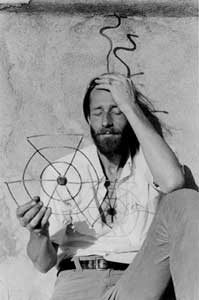
Ira
Cohen published a series of books and broadsides, the Bardo
Matrix Starstream Editions. The first edition, Gregory Corso's
Way Out, a play/poem, was performed once at the Yak and
Yeti Crystal Ballroom by Ira, Angus and writer Bill Barker.
All the publications were printed on rice paper.
The
paper, made from a bush called Daphne, was the main industry
in the valley. The delicate material often contained plant forms,
mica and the occasional insect.
Angus
was always looking for new varieties; he once found a lovely
paper in the village of Toshe and called it Speckled Toshe.
He immediately wanted the exclusive distribution of the product;
actually in the last year of his life he tried to establish
a handmade paper business called Himalayan Paper, Incorporated.
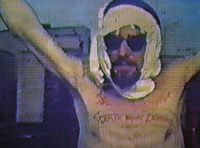
Bardo
Matrix published Angus' Subliminal Report. A woodblock
profile made by Ira Cohen graced the cover, and included were
2 photo's printed in silver ink, one a Mylar portrait of Angus
taken in New York.
Cloud
Asylum was published at the same
time by the Spirit Catchers' Dreamweapon imprint. It had an
identical cover to the Subliminal book but was printed
in red ink instead of black. His poetry was almost prose now,
hermetic stories layered with mystical images.
Angus
made occasional trips to the west, in 1976
for a poetry reading during the Millennium Poetry and Multimedia
Performance (in New York). He travelled to Paris with Hetty, Ossian, Ira and Petra
Vogt and accompanied Ira during his reading about the Kumbha
Mela at the Tropeninstituut in Amsterdam. That same year saw
him in London where he was editor for the Wide Awake Papers
which were used as an insert for the International Times. It
had some of his poetry, works by Lama Gendun Rimpoche and a
history on the Kathmandu scene. In New York he played and recorded
with Bill Breeze and Marc Slivka, but by that time his health
was deteriorating due to excessive use of drugs for years.
He
returned to Kathmandu and made one last trek through the Himalayas.
It proved too much for him and he had to be carried back.
Angus
MacLise died on the Summer Solstice, June 21, 1979 at the Shanta
Bawan Hospital in Kathmandu. He was cremated to the traditions
of the Tibetan Buddhists.
His
life had been dedicated to Art. In his own words: "I followed
a curve through poems, calligraphy, music and journey, humming
with as many beings as possible."
-----
This
article merely scratches the surface of his work. There is still
so much unexplored. An enormous amount of taped music, unpublished
poems and calligraphy. A wealth of material!
Until
now the most interesting releases are on Quakebasket/Siltbreeze:
the CD's áThe Invasion of Thunderbolt Pagoda (SB78) and
Brain Damage in Oklahoma City (SB81).
Angus
can also be heard on The Majoon Traveler, a CD by Ira
Cohen (Sub Rosa SR62), Gerard Malanga's Up from the Archives
(Sub Rosa SR170) and on a Jack Smith CD compiled by Tony Conrad
Les Evening Gowns Damnees (Audio Artkive/Table of the
Elements 46)
The
Fierce single and the soundtrack for Chumlum can be found
on a privately released album from 1998 just called Angus
MacLise (Counter Culture Chronicles 1).
Probably
still in print is the bookáRatio: 3, Media Shamans Vol. I
published in 1991 by the Temple Press in England. Besides Angus
it also features work by Ira Cohen and Gerard Malanga.
-----
Thank
you Tim Barnes at Quakebasket for the support, thank you Gerard
Malanga for the Angus MacLise Collection Checklist, and thank
you Ira Cohen for your time and stories!
-----
(This
article originally appeared in Green
Groceries.)
|
